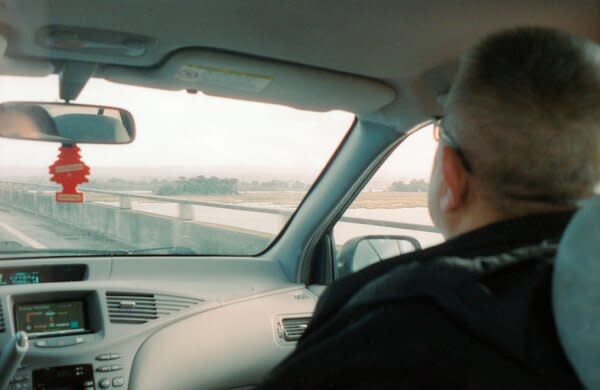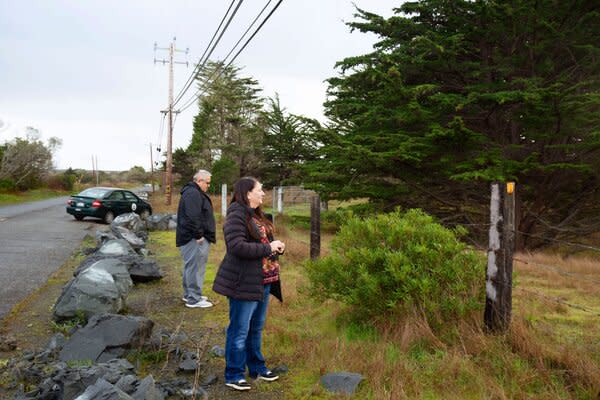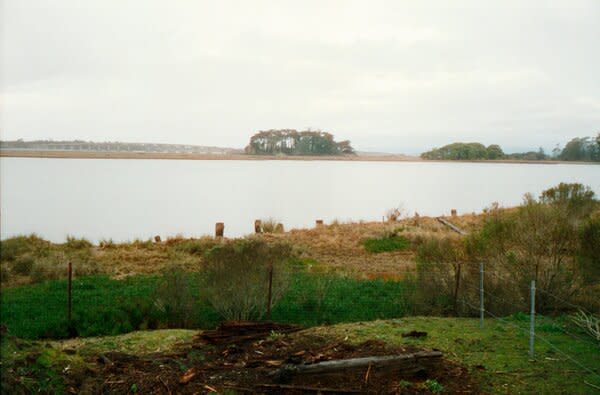The Wiyot Tribe Is Getting Its Land Back and Making California More Affordable
Using the first community land trust developed under tribal law in the United States, the group is turning empty buildings in the coastal city of Eureka into transitional housing.

In early February, a light rain sprinkles across the windshield of Michelle Vassel’s forest green Prius, an official vehicle of the Wiyot Tribe. She’s driving south along the CA-255 bridge toward Eureka, a coastal city in Northern California, passing Tuluwat Island. Ted Hernandez, chair of the Wiyot Tribe, sits in the passenger seat, observing the island—the sacred cultural center of the tribe’s cosmological universe. He and Vassel, the tribal administrator, are surveying the ancestral lands the tribe has recovered in the last 20 years.
In the evenings, Vassel says, some unhoused people walk north across the two-lane bridge to make camp or find shelter on one of the islands in the middle of the bay or farther north in Samoa, a forested peninsula across the waters. They then walk back to Eureka the next day for social services.
Tuluwat Island sits in what is now Humboldt Bay. Many Wiyot people lived on the island until 1860. That year, a group of white settlers interrupted the Wiyot Tribe’s World Renewal Ceremony on the island, killing scores of Wiyot people, mostly women, children, and elders—an act so vicious, it earned the city the nickname Murderville by newspapers in San Francisco and New York. Afterward, the bay was full of blood, Vassel says. For more than 150 years, the island remained out of Wiyot hands until the tribe began purchasing it piece by piece in 1999. Now, the tribe owns most of the island and has created a historic connection with the people of Eureka.
"This has been an intergenerational movement to heal the island, to heal our people, to heal our community. Today we make history together," Hernandez said at a news conference among Eureka’s city leaders the day the last land was returned in 2019. "We changed their story."
"I like to think I just happened to be one of the lucky ones that was alive and here when that happened," says Vassel. "But, you know, work had been done for generations getting to that point."
While returning land to tribes is a major achievement, it isn’t a silver bullet solution to the many problems facing the Wiyot and other tribes across the country. Even when land is returned, many Native people still can’t afford to live close by, something especially true in California, where in January the overall median home price exceeded $751,000, according to the California Association of Realtors.
"Our people are being priced out of the local housing market, so just think about that, the depth of that," says Vassel. "The people that have been here for hundreds of thousands of years can’t afford to live here anymore—and that’s happening all across California in Indian Country."
So the Wiyot Tribe is not stopping at just getting land back. After years of preparation, in February 2020, it took the historic step of creating the first community land trust (CLT) developed under tribal law in the United States.
CLTs are nonprofit development corporations representing residents of a certain area. The trusts use private and public funds to acquire and manage land on behalf of their constituents to create things like public amenities or housing. Residents can own or rent housing on CLT land but cannot own the land and usually live on CLT property using ground leases, which often last 99 years. Perhaps the most beneficial part of a CLT is that when a trust buys the land, the land permanently leaves the market and the CLT is able to keep rental or mortgage rates low on its housing units. The first community land trust in the U.S. was founded by civil rights advocate Robert Swann in 1970 to give Black sharecroppers an opportunity to collectively own the land they worked. As of 2021, there were over 260 CLTs across the country, according to the Georgetown Climate Center.
See the full story on Dwell.com: The Wiyot Tribe Is Getting Its Land Back and Making California More Affordable
Related stories:




